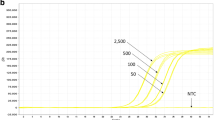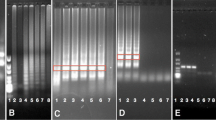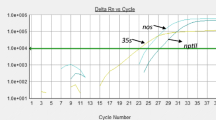Abstract
For routine analysis of the most different food and feed matrices for genetical modification screening methods have increasingly been applied during the past years as the first step of detection. Screening for frequently used regulation elements and recombinant DNA-constructs by the use of real-time PCR is the state of the art. By combining several screening methods, the number of lines of genetically modified plants existing in one sample can be delimited. Apart from the genetically modified plants authorized in the EC, for which reference material and detection methods have to be made available by the placer on the market, there has been an increase of unauthorized GMO on the European market recently, for which event specific detection methods are not available as a rule. It does therefore have to be the target of routine controls by the laboratories charged with surveillance to be able to detect as much as possible of genetically modified plants with the aid of just a few screening PCR methods. Three different construct specific real-time PCR methods are presented in this study. They amplify the junction sequence from the 35S-promoter or the nos-promoter to the nptII gene. Furthermore, a gene specific real-time PCR method for the detection of DNA sequences of the nos-promoter from Agrobacterium tumefaciens is presented.
Zusammenfassung
Zur Routine-Untersuchung verschiedener Lebens- und Futtermittelmatrizes auf gentechnische Veränderungen werden in den letzten Jahren zunehmend Screeningverfahren als erster Nachweisschritt angewendet, mit denen häufig eingesetzte Regulationselemente und gentechnische Konstrukte nachgewiesen werden. Der Stand der Technik ist hier die Anwendung der real-time PCR. Durch Kombination mehrerer Screeningverfahren kann die Zahl der in einer Probe vorhandenen Linien gentechnisch veränderter Pflanzen eingegrenzt werden. Neben den in der europäischen Union zugelassenen gentechnisch veränderten Pflanzen, für die Referenzmaterial und Nachweisverfahren durch den Inverkehrbringer zur Verfügung gestellt werden müssen, gelangten in jüngster Vergangenheit vermehrt nicht zugelassene GVO auf den europäischen Markt, für die in der Regel keine Event-spezifischen Nachweisverfahren zur Verfügung stehen. Ziel der Routine-Kontrollen der für die Überwachung zuständigen Labore muss es daher sein, mit Hilfe weniger Screening-PCR-Verfahren eine möglichst große Anzahl an gentechnisch veränderten Pflanzen detektieren zu können. Hier werden drei verschiedene Konstrukt-spezifische real-time PCR-Verfahren vorgestellt, die als Zielsequenz jeweils den Sequenz-Übergang aus einem Promotor (P-35S bzw. P-nos) in das nptII-Gen amplifizieren. Außerdem wird ein Gen-spezifisches real-time-PCR Verfahren für den Nachweis von DNA-Sequenzen des nos-Promotors aus Agrobacterium tumefaciens präsentiert.







Similar content being viewed by others
References
Altschul SF, Gish W, Miller W, Myers EW, Lipman DJ (1990) Basic local alignment search tool. J Mol Biol 215:403–410
Anonymous (2003) GMO-Watch report: genetically modified crops: molecular and regulatory details. Version 2. http://www.bats.ch/gmo-watch/GVO-Report140703.pdf
Arumuganathan K, Earle ED (1991) Nuclear content of some important plant species. Plant Mol Biol Rep 9:208–218
Bayer BioScience (2006) Grain testing method for detection of rice GM events containing P35S::bar sequences using RT-PCR protocols PGS0494 and PGS0476. Molecular and Biochemical Analytical Services (MBAS) N:V; Technologiepark 38; 9052 Gent; Belgium
Busch U, Pecoraro S, Posthoff K, Estendorfer-Rinner S (2004) Erster Nachweis einer gentechnisch veränderten Papaya in Europa. Beanstandung eines in der EU nicht zugelassenen gentechnisch veränderten Organismus 100:377–380
Community Reference Laboratory for GM food and feed (2005) http://gmo-crl.jrc.ec.europa.eu/bt10update.htm
Community Reference Laboratory for GM food and feed (2006a) http://gmo-crl.jrc.ec.europa.eu/LLRice601update.htm
Community Reference Laboratory for GM food and feed (2006b) CRL assessment on the validation of an event specific method for the relative quantitation of maize line MON 810 DNA using real-time PCR as carried out by Federal Institute for risk assessment (BfR). Biotechnology and GMOs unit
Community Reference Laboratory for GM food and feed (2006c) Event-specific method for the quantification of amylopectin potato event EH92-527-1 using real-time PCR. Protocol EH92-527-1
Community Reference Laboratory for GM food and feed. (2009) Report on the verification of the performance of a construct-specific assay for the detection of flax CDC triffid event FP967 using real-time PCR see http://gmo-crl.jrc.ec.europa.eu/flax.htm
ENGL (European Network of GMO Laboratories) (2008) Definition of minimal performance requirements for analytical methods for GMO testing. http://gmo-crl.jrc.ec.europa.eu/doc/Min_Perf_Requirements_Analytical_methods.pdf
Feinberg M, Fernadez S, Cassard S, Bertheau Y (2005) Quantitation of 35S promoter in maize DNA extracts from genetically modified organisms using real-time polymerase chain reaction, part 2: interlaboratory study.). J AOAC Int 88:558–573
Genetic ID (2009) NOST-Spec construct-specific method for the detection of CDC Triffid Flax (Event FP967) using real-time PCR. http://gmo-crl.jrc.ec.europa.eu/flax.htm
Grohmann L, Brünen-Nieweler C, Nemeth A, Waiblinger H-U (2009) Collaborative trial validation studies of real-time PCR based screening methods for detection of the bar gene and the ctp2-cp4epsps construct. doi:10.1021/jf901598r. http://cera-gmc.org/index.php?action=gm_crop_database
International Organization of Standardization (ISO 21570) (2005) Methods of analysis for the detection of genetically modified organisms and derived products – quantitative nucleic acid based methods
Mäde M, Degner C, Grohmann L (2006) Detection of genetically modified rice: a construct-specific real-time PCR method based on DNA sequences from transgenic Bt rice. L Eur Food Res Technol 224:271–278
Methodensammlung der Länderarbeitsgemeinschaft Gentechnik (LAG) (2005) PCR-Nachweis der 35S-nptII-Übergangssequenz, der pNapin-BayTe-Übergangssequenz und des plsC-Gens; erstellt vom Unterausschuss Methodenentwicklung des LAG. http://www.lag-gentechnik.de/dokumente/uam-methoden/ok_laurical_raps.pdf
Methodensammlung der Länderarbeitsgemeinschaft Gentechnik (LAG) (2006) Real-time PCR for the quantification of genetically modified rapeseed lines using 35S/pat construct. J Verbr Lebensm 3:111–114. http://www.lag-gentechnik.de/dokumente/uam-methoden/SOP_UAM_pat_quant_28032006.pdf
Regulation (EC) No 1829/2003 of the European parliament and of the council of 22 September 2003 on genetically modified food and feed. Off J Europ Union L268/1
Reiting R, Broll H, Waiblinger H-U, Grohmann L (2007) Collaborative study of a Tnos real-time PCR method for screening of genetically modified organisms in food products. J Verbr Lebensm 2:116–121
Swiss Food Manual (SLMB) (2001) Eidgenössische Drucksachen und Materialzentrale, SR 311.510, CH-3003 Bern, Switzerland
Waiblinger H-U, Grohmann L, Mankertz J, Engelbert D, Pietsch K (2009) A practical approach to screen for authorised and unauthorised genetically modified plants. Anal Bioanal Chem 396:2065–2072
Zeitler R, Pietsch K, Waiblinger H-U (2002) Validation of real-time PCR methods for the quantification of transgenic contaminations in rape seed. Eur Food Res Technol 214:346–351
Author information
Authors and Affiliations
Corresponding author
Rights and permissions
About this article
Cite this article
Reiting, R. Real-time PCR methods for the detection of DNA constructs with the nptII gene for the detection of genetically modified plants in food, feed and seed. J. Verbr. Lebensm. 5, 377–390 (2010). https://doi.org/10.1007/s00003-010-0617-8
Received:
Accepted:
Published:
Issue Date:
DOI: https://doi.org/10.1007/s00003-010-0617-8




